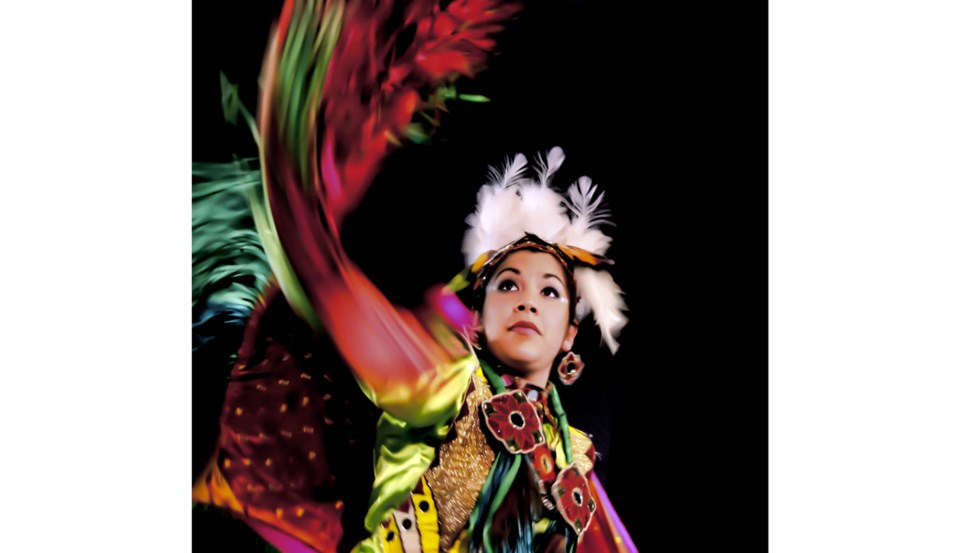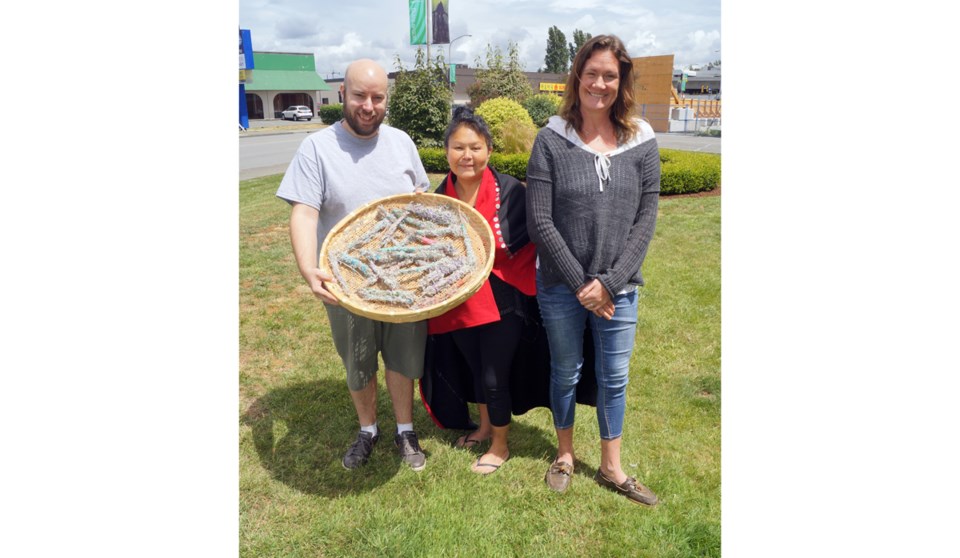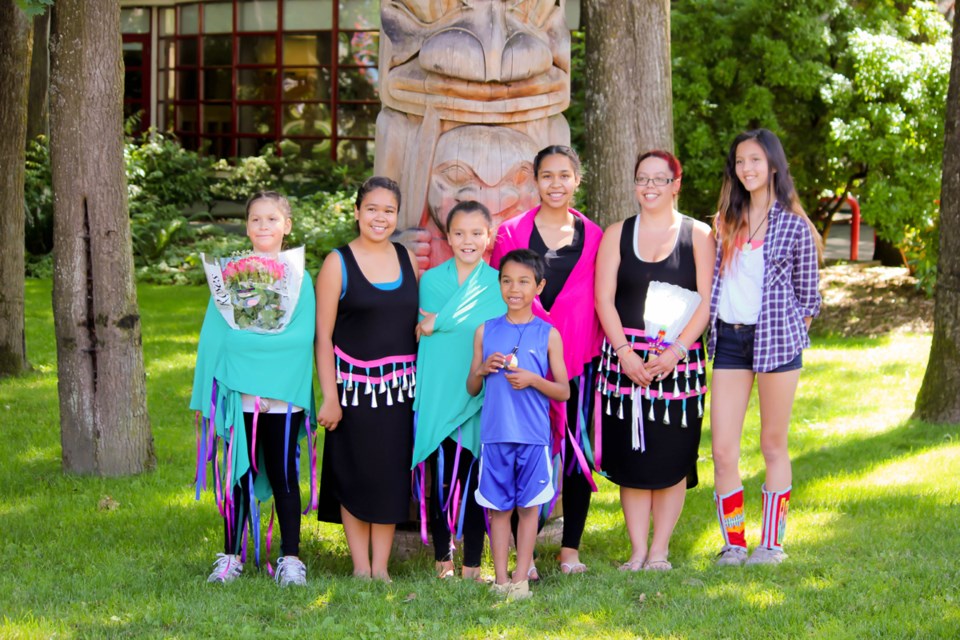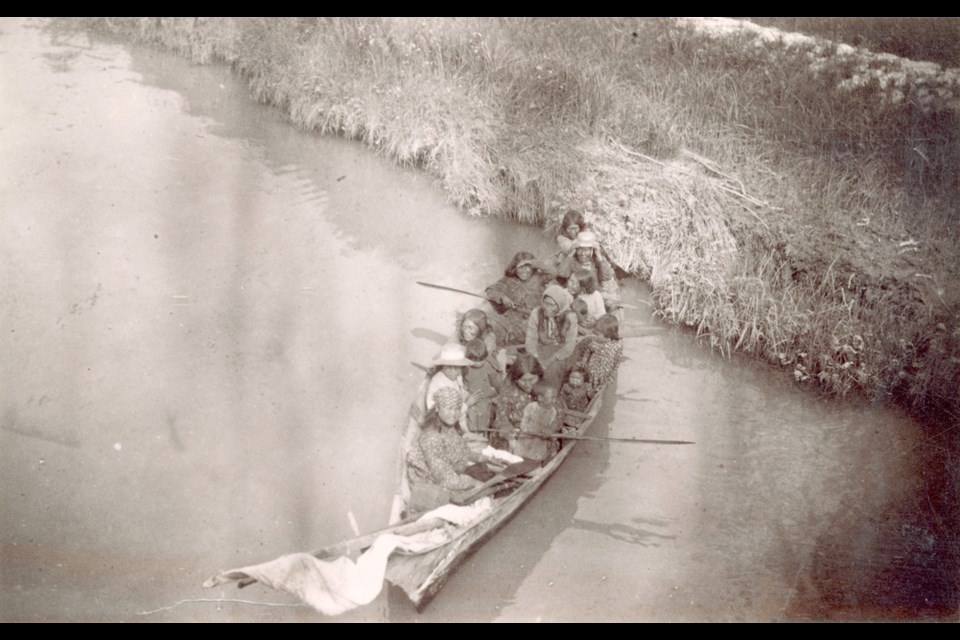The Richmond News understands the prefer term to describe First Nations people is Indigenous not Aboriginal. However, this story was written in 2017 when that was not the case. As such, it refers to National Aboriginal Day, Pathways Aboriginal Centre and uses the word Aboriginal throughout. We have opted to not go back and edit the story as we believe that would be a form of rewriting history and discounting the evolution of language. That said, we recognize the term does not reflect current journalistic practise.
There was no thudding of trucks on bridge decks, roaring of airplanes, sounding of ship horns, screeching of wheels. The sounds of the city that now echo over the Salish Sea did not persist for the ancestral Coast Salish people, who lived alongside and in what is now known as Richmond.
In fact, Richmond didn’t even exist when the Aboriginals first planted roots in the region.
“We’ve been welcoming people to this area before there was land to stand on,” explained Musqueam councillor Morgan Guerin, speaking from his home on the Musqueam reserve in South Vancouver, a stone’s throw from Richmond.
The Musqueam are some of the first people of this land, now known as Richmond, and this Saturday marks National Aboriginal Day, a day for Aboriginal communities across Canada, including here in Richmond, to celebrate their culture.
Today, it is thought that about two in every 100 Richmondites has Aboriginal ancestry. It is a community that continues to find, and fight for, its voice after an era of what can be described as genocide and cultural genocide against Aboriginals.
“The Musqueam are part of your history,” said Guerin. “If you come to live here, you need to know the history of this land, and it doesn’t start 150 years ago.
“Our oral history predates the land of Richmond,” noted Guerin.
Richmond rises
About 9,500 years ago, Richmond rose from the silt deposits of the Fraser River, which didn’t exist along the shores of the main Musqueam village, north of where Sea Island is now.
Imagine a shallow, open ocean, from South Vancouver to Tsawwassen. Settlements were also set up where North Delta now exists, closer to the then mouth of the river.
By 3,500 years before present day, Lulu Island had finally stabilized. It was around this time that Guerin explains that the ancient village of c̓əsnaʔəm was a base to one of the largest ports in the world.
People of the Eel Grass
The Musqueam are Coast Salish people, who lived up and down the shores of the Pacific Northwest and were once the largest group of Aboriginals north of California. They speak Halkomelem or, more specifically to the Musqueam, hǝn̓q̓ǝmin̓ǝm̓.
According to the Archeological Heritage Resource Overview of Richmond, by Dr. Leonard Ham in 1987, what is now Richmond belonged to the Musqueam, Tsawwassen and Kwantlen families. However it is believed that the Musqueam used the land the most, particularly in the preceding 2,000 years.
“The resources came to our door. We had to protect them, and, because of that, our culture flourished,” said Guerin, who notes it’s important to recognize that land was not privately owned in the sense modern society knows today. Rather, the land was passed down by generations. Notably, Aboriginal families from Vancouver Island also had rights to use resources from Richmond’s many islands. Guerin said oral histories indicate peaceful times amongst coastal tribes.
In the thousand years preceding present day — and before a smallpox outbreak spread rampantly in villages and temporary settlements in the 1780s, killing about 75 per cent of the population — it is believed that as many as 2,000 people lived in present-day Richmond during the winter. However, when the fish came, the population ballooned to as many as 20,000.
The Coast Salish gathered berries and roots, and hunted deer, muskrats and beavers as they navigated through the grasslands and clusters of spruce forests. And they undoubtedly fished for salmon, sturgeon, seals and sea lions. All of the natural resources they used still exist to some extent in Richmond to this day.
Salmon season (late summer) was a time for potlatching, said Guerin. Richmond had an extensive network of salmon-spawning sloughs discharging into the river and Sturgeon Bank, noted Ham. Along these inside canoe passages — totalling an estimated 101 kilometres — small seasonal camps would be marked by rising smoke and good conversation.
After the smallpox outbreak, the region was under populated, according to Capt. George Vancouver, noted Ham. Vancouver’s journals spoke of abandoned villages with scattered human bones.
“The Coast Salish of Richmond did not escape the ravages of this disease,” wrote Ham.
The Musqueam name comes from “people of the eel grass,” said Guerin, and it is said that the flowery grasses (xʷməθkʷəy̓əm) went extinct when the people started dying.
Although the Truth and Reconciliation Commission only acknowledged “cultural genocide” on the part of European settlers, it is common for Aboriginal leaders throughout North America, such as Guerin, to drop the word “cultural.”
“Genocide did happen. People handed us diseased blankets to remove us from the equation. What couldn’t be killed off, that’s when the cultural genocide occurred,” he said.

Musqueam villages:
Musqueam name - Present day
xʷəy̓qəθən - Sea Island
q̓ʷeyaʔχʷ - Steveston
sp̓ələk̓ʷəqs - Terra Nova
xʷɬic̓əm - Canoe Pass
ƛ̓əqtinəs - Woodward’s Landing
c̓əw̓χeləməɬ - Mitchell Island
Small villages marked Richmond
Early Richmond council meeting minutes from the 1880s contain frequent references to Musqueam resistance to encroachment upon their villages, noted Ham.
The Musqueam never had a name for Richmond. Rather, they named spots along the shoreline. For instance, Terra Nova was Spul’u’kwuks (Anglicized), meaning “bubbling water,” for the gas deposits coming through the sloughs. It was a Musqeaum fishing village, but now it’s a subdivision with a namesake elementary school.
A chart from 1885 shows “Indian” occupation of Garry Point, named after Nicholas Garry, deputy governor of Hudson's Bay Company from 1822-1835. The Musqueam Point family lived there before being removed, said Guerin.
Aboriginals were afforded little respect by Christian settlers. A Musqueam summer camp site at Steveston Wye (now Railway Avenue and Garry Street) was named Kwlhayem, or a “place having driftlogs on the beach.” Testaments indicate that what is now the Westwind neighbourhood was an Aboriginal burial ground. Settlers simply moved bodies further into the bushes to extend Railway to Moncton Street.
“The village site was abandoned by the Indians after the area was bought up for farming,” wrote Ham.
With development, the fishing and navigation sloughs that were so fundamental to the Musqueam culture disappeared. And, in 1987, it was noted by Ham that only nine of 21 archeological sites remained.
Around this time, as noted in the history book Child of the Fraser, there were clashes between whites and Aboriginals.
Aboriginals remained in Steveston as workers at canneries, although they were subjected to racism. Those who left retreated to reserves and children were sent to residential schools.
Replanting the grass
The irreparable damage caused by the residential school system persists to this day. The physical and mental abuse inflicted by the Christian missionaries has scarred past generations, leaving social and economic gaps in the present generation of Aboriginals, according to many in the Aboriginal community, such as Marshall Thompson, executive director of Pathways Aboriginal Centre.
“Often, family isn’t around, or they’ve been in care, and they’re disenfranchised from their family and band,” said Thompson, speaking specifically to young, at-risk Aboriginal mothers, who are a primary concern for Pathways.
The centre, located on Alberbridge Way, is a way to connect Aboriginal people living in Richmond with one another. Social services are provided, but also fun activities for families, such as smudge making, bannock baking, traditional dance lessons, education programs and simply hanging out watching movies in the lounge.

Donda Humchitt, 47, is one of the most active members at the centre, described by staff as a “cultural advisor.”
“I used to find myself going to Vancouver for different things or to find community members, but coming here, we’re finding ourselves as a small community. . . We’re pulling together,” said Humchitt, who grew up in Bella Bella and Campbell River.
Her story is one that is, much like most Aboriginals, not void of conflict and troubles. Luckily, she wasn’t forced into a residential school like her siblings.
But today, as a single-parent and seasonal fisher, she raises four nephews as her foster children along with her three biological sons.
A big issue facing Aboriginal children is disconnect with their culture and history.
The latest emotional rollercoaster occurred last month at a special Aboriginal graduation ceremony at Hugh Boyd secondary.
“These kids didn’t know where they’re from. They’d be asked, ‘What is your background?’ And they didn’t know. It hurt my feelings, but it hurt my kids’ feelings even more. They’re all boys and they all came home and asked, ‘How come they don’t know who we are or where we’re from?’”
Helping bring awareness to Aboriginal people is Jelica Shaw, program coordinator at the centre.
“We like to celebrate who Aboriginal people are and their successes. By participating in this (graduation) ceremony, it’s the first step in beginning to know where you’re from,” said Shaw, who helps organize, among many other things, a homework club whereby Aboriginal university students tutor high school students.
Shaw said cultural knowledge has allowed youth “to navigate through a lot of bullying and racist remarks.”
Child youth and family worker Jeremy Schroeder noted teaching non-Aboriginals about Richmond’s Aboriginal community is important for the broader Richmond community.
“Our after-school program for older youth, some of them are so excited to bring friends from other cultures to experience something that’s more traditional,” said Schroeder.
Stigmatization continues
To be certain, said Thompson, the centre is facing an uphill battle in many respects.
For one, it’s underfunded for the programs that are needed, especially for at-risk parents and children under the age of six.
“If you put the right circle around someone it works,” said Thompson.
But that doesn’t usually happen. The Ministry of Children and Family Development has no problem taking a child away from a family, however what often happens is they get lost in the system, said Thompson, who, during the course of a conversation with the Richmond News, described Aboriginal families living in dirt-floor basement suites in east Richmond, a young mother trying to escape prostitution and a continued effort to steer at-risk youth away from Vancouver’s Downtown Eastside.
Systemic discrimination continues, noted Thompson.
For instance, the 2011 census showed Richmond had an Aboriginal population of 1.2 per cent. Thompson noted the centre found most of its clients failed to report their mixed status due to a misunderstanding of the forms. He pegs the Aboriginal population at about 2.5 per cent. Underreporting means less funding for programs.
“The other issue, and something we’ve come up to in our community, is when we try to raise concerns about what’s going on, when you think it’s 1.2 per cent of the population, people think it’s not a priority,” said Thompson.
He noted about one quarter of students at Richmond’s school for at-risk children is Aboriginal.
“So, why are 20-30 per cent of our youth in an at-risk program and only, supposedly, one to 2.5 per cent of the population is Aboriginal?”
One problem could be how Aboriginal youth are looked upon in the education system.
In an ironic case of what could be described as “reverse discrimination,” Thompson said Aboriginal families prefer not to identify as such because the children will be taken out of class to participate in special programs to “help” them.
“A lot of families don’t check the box because they get pulled out of class” by Aboriginal groups, for extra assistance.
“Then all the other kids look at them and say ‘What’s going on? Why are you different?’ rather than try to just educate classes about Aboriginal ancestry and allowing someone to increase pride and self-disclose and seek support, if they need it. It’s almost a reverse discrimination — we’re going to pull you out and support you.
“As soon as a child discloses they’re Aboriginal, statistics show their teacher’s expectations are reduced,” said Thompson.
This is why there are only about 200 Aboriginal students registered in the Richmond School District, despite there being several hundred more.
“If they’re in foster care, they need to check the box. And there are about 200 kids in foster care in Richmond,” said Thompson, noting the graduation rate for registered Aboriginals (ie. those in foster care) is 60-70 per cent, whereas the youth who attend his centre are graduating at a 90-plus per cent clip.
Shaw noted that university transcripts also show if an Aboriginal student received special assistance.
An upbeat drum beat will be heard this Saturday

What is needed is a holistic approach, argue the centre’s workers, which brings an upbeat Shaw to explain National Aboriginal Day celebrations occurring in Steveston this Saturday, at the Gulf of Georgia Cannery.
“It’s going to be great. The kids have put so much time into their dance,” said Shaw, of the Richmond Powwow Dance Group.
The group is comprised of Aboriginal students of all ages.
“It’s an opportunity for the greater community to come see we do have an Aboriginal community. And it’s a big boost to the self-esteem of these kids to show what they’ve been doing in the school year.”
Also on tap at the event is entertainment from SisterClan, Stories with Henry Charles (Musqueam) and Stay in School Awards.
The celebration runs from 1-3 p.m. at 12138 Fourth Avenue. For more information, call Shaw at 604-271-7600.
The Aboriginal Centre is a part of Richmond Youth Services Association. Visit RYSA.bc.ca
*The print version of this story erroneously identified the origins of Garry Point. This online version has been corrected.


